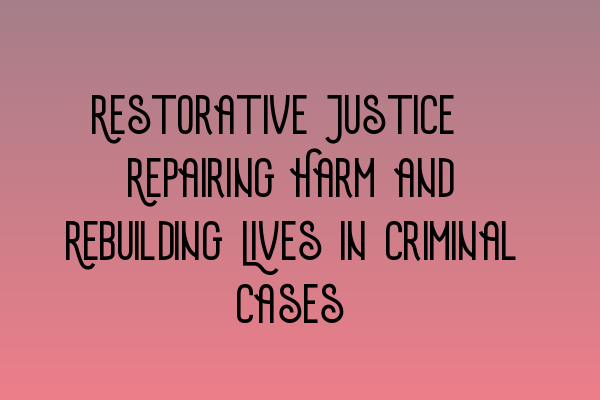Restorative Justice: Repairing Harm and Rebuilding Lives in Criminal Cases
In criminal cases, the traditional criminal justice system focuses primarily on punishing offenders and deterring future crime. However, there is an alternative approach that aims to address the needs of the victims, the offenders, and the community as a whole. This approach is known as restorative justice.
Restorative justice is a process that brings together the victims, offenders, and the community to discuss the harm caused by the offence and to find ways to repair that harm. It emphasizes accountability, rehabilitation, and reconciliation, rather than solely focusing on punishment.
One of the key principles of restorative justice is the recognition that crime hurts not only the immediate victim but also the community as a whole. By involving the community in the resolution process, restorative justice aims to repair the social fabric that has been damaged by the offense.
Restorative justice is based on the belief that crime is a violation of people and relationships, and that the focus should be on repairing those relationships, rather than on exacting revenge or punishment. It provides an opportunity for victims to have their voices heard and to actively participate in the decision-making process.
Through restorative justice, victims can express the impact of the crime on their lives and receive direct apologies or make arrangements for compensation. This can help victims find closure, regain a sense of control, and move forward in their lives.
Similarly, restorative justice offers offenders the opportunity to take responsibility for their actions and to make amends. It allows them to understand the consequences of their actions on the victims and the community, fostering empathy and facilitating rehabilitation. This approach has been shown to reduce recidivism rates, as offenders are more likely to understand the impact of their actions and strive to change their behavior.
Restorative justice also benefits the community by involving its members in the resolution process. By witnessing the consequences of crime and participating in the restoration of relationships, community members can develop a deeper understanding of the harm caused by crime and contribute to its prevention.
Restorative justice is not a one-size-fits-all solution. It requires careful planning, facilitation, and the commitment of all parties involved. Trained mediators or facilitators play a crucial role in guiding the process and ensuring that it is fair, respectful, and constructive.
Restorative justice can be used at different stages of the criminal justice process, including during pre-trial, post-conviction, and post-sentencing. It can be applied to a wide range of offenses, from minor crimes to serious offenses, and in both juvenile and adult cases.
While restorative justice is not meant to replace the traditional criminal justice system, it offers an important alternative that can complement and enhance the existing system. It can provide a more victim-centered and community-oriented approach to justice, fostering healing, reconciliation, and the prevention of future harm.
If you want to learn more about the SQE Criminal Law & Practice in the UK, consider checking out these related articles:
